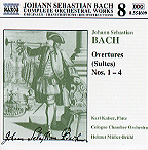After his hypersonic and occasionally reckless Brandenburgs, Helmut Müller-Brühl gets the tempos and balances right for the four Orchestral Suites. Technically solid and buoyant in spirit, the performances really take off, largely due to an approach that allows the character of each dance to set the tone for each movement. Although we’re hearing (mostly) modern instruments (there are natural trumpets and what sounds like a Baroque flute), the playing style is centered in currently accepted conventions of Baroque performance practice, including clean, distinctly articulated bowing, a bright, lean string sound, and limited vibrato. Happily, Müller-Brühl doesn’t indulge in distracting double-dotted French overture fussiness or similar affectations that some conductors find irresistible. Instead, we get fine, straightforward performances with plenty of energy and verve–no quirky ornaments or extreme tempos.
And, speaking of tempos, the famous “Air” from Suite No. 3 is perfectly paced, its interpretive manner gentle and confident without Romantic pretension. The following gavotte movement, which often is run over in a mad rush by conductors and players over-eager to show off, here is given air and space enough for us to feel it as a legitimate dance. Karl Kaiser’s virtuosic flute solo (“Badinerie”) is on par with the finest recorded versions (remember the smashing Swingle Singers rendition of a few decades ago?). There are Baroque orchestras that play with even more clarity and polish (Les Violons du Roy) and there are several excellent specialist ensembles that are much better known (Tafelmusik; Amsterdam Baroque Orchestra), but none of these currently has a recording of this music in the catalog. Besides, no one looking for well-played, reliable interpretations of these core repertoire pieces, in very fine sound, will be disappointed with this choice. A good basic set.
































